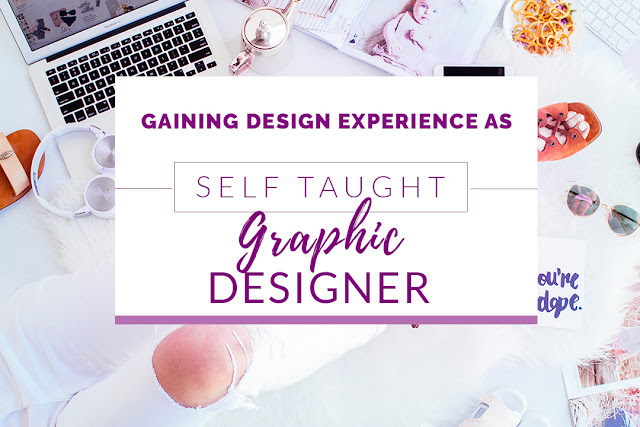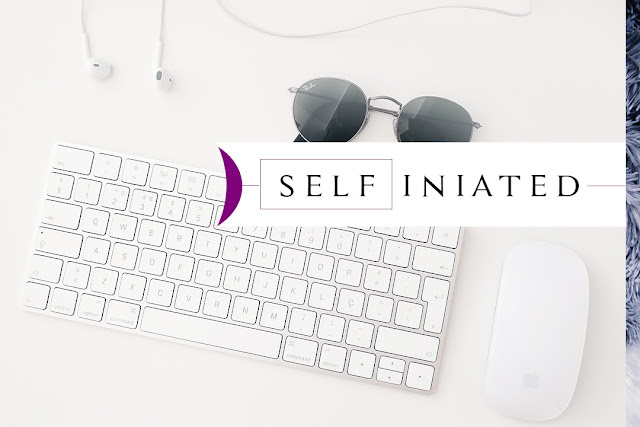
One of the best ways to gain some official design experience as a self taught Graphic Designer is by Freelancing.
Freelancing gives you the freedom to work with clients at your own time, and choose which graphic design projects you are comfortable working with. As you are just starting out you might want to take on the smaller projects that you know you can easily accomplish, and then progress onto bigger more complex projects. Why do so?
Bigger projects pay a lot more money, but if you have never worked with a client before you will set yourself up for failure. There will be demands that you will not be able to keep up with or certain tasks that you just aren't ready to handle, and deadlines that you just cannot meet as you aren't used to it. That will lead to a ton of disappointments, and many bad reviews that could tarnish your reputation.
When freelancing start small to rack up some experience, and learn what interacting with customers will be like. If you are stressed out with the smaller projects just imagine how much more stressful bigger clients will be if you start working at a design company. Over time you will get used to the workload, revisions, customer service (yes, communication is key in this business), and deadlines. Soon enough you will have mastered graphic design in the online world.
As a graphic design freelancer, you will have a lot of flexible hours and can choose to work remotely or on location.
There are platforms available that enable entry level to expert graphic designers to find clients such as:
- Freelancer (5% fee, but has some technical difficulties at time)
- Upwork (20% fee has some good clients, but most of the work posted are too cheap, and not really worth the time)
If you are a self-taught graphic designer that would like to sell premade templates instead you can use the following sites:
- Creative Market (apply with portfolio to be considered. The review process is strict)
- Envato Market Place (each submission goes through a review process, and it is a bit strict)
- Uplabs (first few submissions go through a review)
My tips for self-taught freelancers:
- Pay your taxes. Before you start on your freelancing journey I recommend staying informed with the tax laws in your country if it requires paying taxes. If you need help please consult with an accountant when possible. You can also use a software like quickbooks to give you a helping hand. Will you be paying your taxes quarterly or annually?
- Learn about contracts, and how to create one for your needs (you need to create a contract between you, and the client so that they know what is expected from your mutual working relationship). You can use a site like hellobonsai to write up a basic contract from their sample template.
- Use a good payment system. If you will be freelancing from your own website or platform make sure you have a reliable payment system in place. Ask yourself the following:
- Will my clients be paying the full price for my designs upfront or will they pay half now, and the rest later at the end of the project?
- Do I offer full or partial refunds?
- Make an invoice for all your clients (keeps you more organized, and allows you to track each of your projects for tax season). You can use invoicing software like the following:
- Zoho Invoice (free for up to 5 clients single user
- Freshbooks (30 day free trial no credit card required. If you don't continue past the free trial you will not be able to log into your account to see your past invoices so keep a copy of those records in case you do not continue)
- Quickbooks (30 day free trial)
- Know when to say "no" to a project. For example, if the client is making too many demands or asking for extra items to be delivered that isn't included in what they paid for. Do not let yourself be taken advantage of like an idiot. Value yourself as well as your time.
- Keep on learning! Constantly learn to increase your skills, and knowledge in design. You might come across a method that truly kick starts your career
- Produce high-quality designs. When making premade templates ask yourself:
- would I buy this design template?
- Is it easy for consumers to edit?
- Is it in good quality?
- Market yourself constantly. Make sure you stay active on your social media platforms, and showcase your latest work. I made a list of how to promote or market yourself here.

As a graphic designer you will get a ton of client briefs.
In short, briefs are basically details on a client's project.
For example, let's say a client wants a logo design. Their brief will state what type of logo they want (illustrated, text, etc), which colors they like, the font styles they need, the number of concepts they want you to provide, the message they want the logo to send out (insurance company, pizza restaurant, etc), the competitor logos that they like, and much more.
It's basically specific details on what they want you to do for them, and the message they want you to send out about their brand. If you have no idea what a brief looks like you can browse a site like 99Designs, Designcontest, or any other contest site to get an idea of what clients might throw at you.
You do not have to enter these contest sites if you do not want to this is just to get a taste of what some clients might post in their briefs. These sites are usually very controversial as hundreds of designers do not get paid (spec work).
As these are contest sites not everyone gets paid for submitting a design, but some freelance graphic designers make a living from crowdsourcing design sites while others use it to build their portfolio.
Many designers have a love hate relationship with these contest sites, but your thoughts on them are your own. Whether you like them or not that is your personal thought, and decision. Your reasoning is your own.

Self Initiated Projects
Once you have seen an example of what a graphic design brief looks like I recommend that you create 3 - 5 graphic design briefs of your own as a test project to build up your portfolio. From this you will see your graphic design skills gradually improve, and you will master knowing exactly what you need from a client when working with them if something is missing.
Once you jot your ideas down, and sketch your concept get started on redesigning the brand, website, or product. For example, let's say you are a self taught website designer browsing facebook, and your thinking about re-designing your version of it.
You should ask yourself:
What's right with facebook's current design?
What's wrong with facebook's current design?
What's missing from facebook's current design?
How can I improve it?
Once you find the answer to those questions your ideas will breeze right onto your designing canvas. When you are satisfied with the current look of your redesign I recommend creating an account with Behance, and adding that to your porfolio. Behance is filled with designers ready to give you some helpful feedback, criticism, and uplifting comments. You might even be scouted by the company itself, and get hired (some designers have gotten hired through this method--it doesn't work for everyone, but it might just for you). You can even go the extra mile, and share it on social media for more exposure/work opportunities. This isn't limited just to website design; you can recreate a product packaging design or logo as well--the possibilities are in your fingertips.
Summary of steps in a nutshell:
- Create 3 - 5 briefs based on
- Your own design or a redesign
- Share on behance, and social media
Here are a few examples of redesigns that practically went viral:
 |
Google Search Concept Redesign
|
 |
Google Play Music Redesign
|
 |

Talking to people in real life can also have its benefits.
Design, and communication work hand in hand so applying it in reality will give you a jump start. Do not be shy--it will kill your progress. Go to your local stores, hair salons, photography studios, etc and get to talking. Market yourself, and let them know about your graphic design skills.
You can say that you are currently having a promotion, and would like to offer them a free trial of your graphic design services. Design a free promotional poster, business card, t-shirt, etc. Personally, I have benefited from talking to local start ups using the same techniques, and landed not only a Graphic Design position, but also experience as a beginning filmmaker.
When people see you, and meet you in real life you are not just some random person working behind the computer with a sketchy "that may or may not be me" photo as a profile pic. They know who you are (they can see your face, and know your name) so in turn you become a more credible and trustworthy source especially when you show them you portfolio, and the experience you've gained as a freelancer.
Quick Tips about pricing:
Your pricing truly depends on where you live so I cannot tell you how to price your graphic design services. It truly depends on you, and your community. For example if you are going to promote your design business locally, and you live in a low income neighborhood it would not be ideal to pitch a $25,000 design service to someone who makes that or less in an entire year--they'll need that money for themselves as well as family so they cannot afford you. You will most likely have no clients. Keep your prices reasonable to both you, and your clients.
This does not mean that you have to devalue your services, but instead remove any extra services that comes with your design package. For example, if you create branding for multiple products cut it down to just one or two. Offer smaller services for cheaper prices.
If you live in a high income neighborhood where the demand for graphic designers are high then you can pitch your higher quality pricier design services. Offer bigger services for expensive packages.
These are simply my suggestions based around what has worked for my friends, and some of my experiences so they are not set in stone. There are different ways to get graphic design experience. If you have any suggestions leave them in the comments below!












Accountants for self-employed
ReplyDeleteAccountants for Self-Employed can make or break your business. Not only must they keep the books, but accountants for self-employed also provides you with all the tools and resources needed to become successful in this competitive world. In order to decide which accountant to choose, you need to think about the type of accountant you’re looking for.
A lot of people struggle with the finance side of self-employment especially with tax. At Naseems, we help make your finances less complicated and help make sure you don’t miss out on schemes that give you a tax advantage.
Self-Employed Accountants!